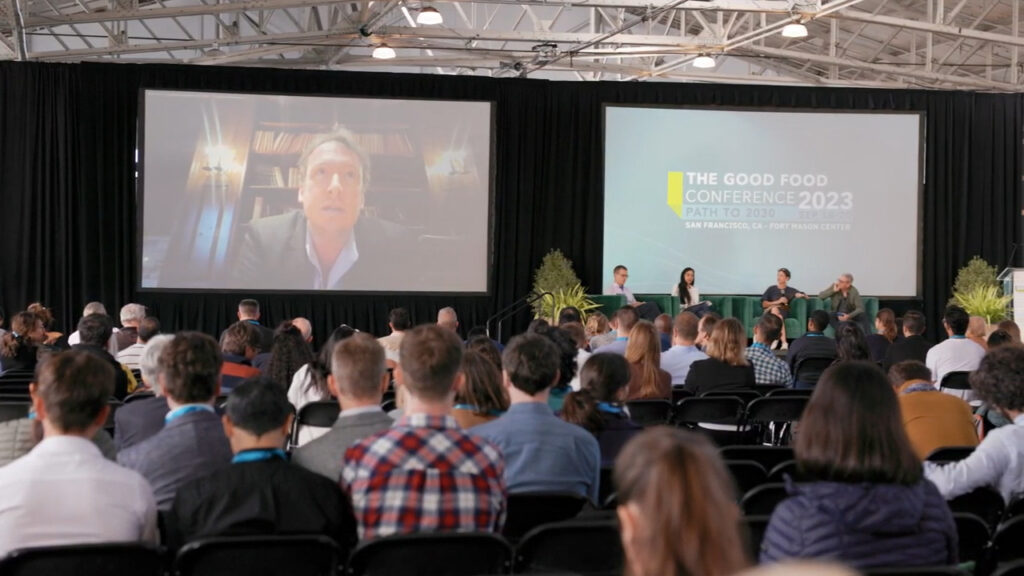Alternative proteins have never looked so good

Transforming food for the better—together
Our flagship gathering, the Good Food Conference (GFC), brings together innovators, scientists, policymakers, industry leaders, and global champions, representing a diversity of places and perspectives. All attendees have at least one thing in common: a desire to build a delicious and more equitable food system. This was the first in-person GFC since 2019, and we were excited to convene so many stellar humans in one place to zero in on a brighter food future.
Through in-depth sessions, workshops, networking, interactive roundtables, meet-ups, and game-changing food, attendees forged new connections, discussed some of the most exciting opportunities, and wrestled with some of the biggest challenges facing the alternative protein field today.
This event would not have been possible without our generous sponsors, who not only supported the conference but were well-integrated into programming throughout. A sincere thank you to these sponsors for their valuable time and resources to help us create a spectacular experience for all attendees.
Capturing a mere handful of moments in a jam-packed three days together is a challenge, but after reflecting on this event, we think you’ll agree that these moments stand out.
Check out our favorite good food moments
The future of alt proteins was at the center of the plate – literally

As part of this year’s menu planning and food experience, more than 20 companies generously donated alternative protein products. In-person attendees experienced delicious meals made from plant-based proteins and overwhelmingly praised the variety and innovation as a key highlight of the Good Food Conference at conference meals and the international Alternative Protein Food Festival. These companies showed attendees how alternative proteins work beautifully with any cuisine.
- The Better Meat Co. – Rhiza Mycoprotein Curry
- Beyond Meat – Beyond Steak, Beyond Breakfast Sausage, Beyond Jerky
- Black Sheep Foods – Black Sheep Lamb
- Cargill – Crave House Plant-Based Chorizo Sausage
- Climax Foods – Blue cheese
- Eat JUST – JUST Egg
- Eclipse Foods – Ice Cream
- ENOUGH Food – ABUNDA chicken-style filet
- Fifth Taste Foods – Harvest Shreds, oo’mämē chili crisp
- House Party – cheesy dip
- Impossible Foods – beef
- Juicy Marbles – Juicy Marbles Whole-Cut Loin
- Meati – Carne Asada Steaks
- MeliBio – Mellody bee-free honey
- Mezés Artisan – Smoked Eggplant Dip
- Motif FoodWorks – Motif PorkWorks
- Nature’s Fynd – Nature’s Fynd Dairy-free Cream Cheese and Meatless Breakfast Patties
- NotCo – NOTBURGER
- OmniFoods – Plant-Based Pork-Style Ground
- Quorn – Meatless ChiQin Fillet
- Rebel Cheese – Cave-Aged Brie
- Sempera Organics – Mamu
- Sundial Foods – Boneless Crispy Chickpea Wings
- TiNDLE – Chicken Patties
- Umaro Foods – Bacon
- unClassic Foods – Oyster Mushroom Steak Tips
“We came away from the Good Food Conference with the optimism that despite all the challenges the industry faces, there are already tangible innovations on the horizon. We feel even more reinvigorated by the passion and ingenuity of the people working in this field. For CP Foods, we look forward to forging new strategic partnerships to scale all these innovations for Asia and the rest of the global market, not just the U.S. or Europe. We also got great feedback about our products, and we are excited to bring them to the U.S. market as soon as possible.”
CP FOOds, GFC 2023 sponsor
Emerging alt protein startups innovated in more ways than one

The pitch slam remained a fan-favorite session at the conference – and for good reason. Some of the brightest emerging innovators in the food sector took the stage to pitch their ideas. This year we broadened the lens to include not just products but processes and ingredients. The session started off with the sound of the audience snapping for a pitch from BioBetter, formatted as a rhyme, which included this excerpt from their five-minute “spoken word” style pitch:
“So let skeptics fade
Let doubts melt away
Molecular farming is here to stay
Let it be recognized
Let it claim its worth
With its unlimited potential
It will save Planet Earth
Let doubts be erased
Molecular farming should be fourth pillar embraced“
As the session moderator Brian Cooley observed, “That’s ambitious, explaining science in meter.” We couldn’t agree more.
“It’s exciting to be able to develop and grow a new category to provide protein solutions. We believe that consumers need more choices for eating healthier, and it doesn’t have to be this all-or-nothing approach to have those choices. There is a need to develop products that address taste, texture, price, and nutrition that previously have not been addressed.”
Greg Dodson, Vice President, Savory, ADM
The personal health benefits of alt proteins spoke loud and clear

The three pillars of alternative proteins—plant-based, fermentation-enabled, and cultivated— have unique value propositions. For plant-based meats specifically, health is still a top driver for consumer purchasing. Communicating nutritional and public health information to consumers must be a priority of the alternative protein industry. Some well-attended discussions at GFC focused on just that, and attendees gleaned important insights, particularly at the panel Leaning into the personal and public health benefits of alternative proteins. Ethan Brown, CEO of Beyond Meat, opened the session with inspirational insights into how the alternative protein industry can support the personal health goals of consumers. If you’re interested in being a more fluent messenger of the personal health benefits of alternative proteins, this session’s cup overflows with insightful comparisons and data.
“We must as a category unite around a single, powerful message that takes back the narrative of our process and ingredients, celebrates them, and educates the consumer on the transformative health outcomes that are available through a plant-based diet that includes plant-based meat.”
Ethan Brown, CEO of Beyond Meat
The public health benefits spoke just as loud

We know that alternative proteins can bring public health benefits, build more stable food systems, stem antibiotic resistance, and help meet climate goals. The second half of Leaning into the personal and public health benefits of alternative proteins focused on how alternative proteins can contribute to healthier, more food-secure societies as a whole. Brent Kim, Research Program Manager at the Johns Hopkins Center for a Livable Future, reflected on the urgency of developing new sources of protein that are better for people and the planet with a powerful call to action.
“Industrial animal agriculture has excelled in producing massive quantities of inexpensive protein. I say inexpensive, referring only to the retail price on the cut of meat. When we account for the social, health, and environmental costs of this system, it’s extremely expensive. Antibiotic resistance is an extremely costly problem. Novel influenza is an expensive problem. The climate crisis is an exceedingly costly problem. I don’t think there’s any one single silver bullet solution to these problems, but the innovators who share this panel with us today are bringing us new options. Now more than ever, we need their work, and we need your work as we stand on the precipice of multiple, irreversible public health and planetary crises.”
Brent Kim, Research Program Manager at the Johns Hopkins Center for a Livable Future
Alternative proteins were elevated as a climate solution

We know that the way we grow food, source ingredients, and manufacture food impacts our climate. No conversation about mitigating the effects of climate change should ignore the way our food system functions. Leaders advancing climate action from across sectors and scales joined us at GFC to help clarify the massive role alternative proteins can play as a global climate solution. The closing session, Alternative proteins as a climate solution, served as both a bookend and a beginning, inspiring attendees to bring their time, talents, influence, persistence, and shared commitment to usher in a future where alternative proteins are no longer alternative. Andy Jarvis, of the Bezos Earth Fund, joined virtually from New York Climate Week to assert that we are at a tipping point for the alternative protein industry.
“There is a seismic shift in the importance of food in the climate agenda right now. There is a moment right now in food that’s similar to the moment renewable energy had a couple decades ago. There’s a lot more focus on food in the environment and sustainability agenda and that’s something that needs to be taken advantage of.”
Andy Jarvis, Bezos Earth fund
“We’re within a few years of price parity. Of course, that depends on the technology, but when you think of scaling technologies like precision fermentation or biomass production, we’re getting close. We need additional scale. We need additional manufacturing facilities to help us do that. When you talk about cell-based solutions, we’re probably further off to get to price parity. But in certain applications, like fish for example, when we have no more fish in the sea, price parity doesn’t even matter. We’re going to have to find other solutions.”
Scott May, Head of MISTA/Givaudan
Academic champions from around the world brought their energy, expertise, and diverse perspectives to the table

Top research universities across the world are beginning to embrace alternative proteins as an important new field of scientific inquiry and opportunity for the future workforce. Throughout the conference, researchers, students, and other academic champions at the center of these developments had the opportunity to collaborate, problem-solve, and learn from each other. We were inspired to see just how much energy and innovation these communities can bring to build mission-critical research and training hubs that will ultimately fuel the next generation of alternative protein innovators. At no session was that better represented than at Case studies for building university research and training hubs, where attendees heard from speakers representing academic communities in Singapore, Belgium, England, Nigeria, Israel, and the U.S. This session illustrated how vast and far-reaching this movement has become and that we need everyone at the table to initiate lasting change.
“I am so grateful that Anchang could join us virtually from Nigeria so we could learn about the incredible work happening at the University of Nigeria. This is one of many examples that the alternative protein space reaches farther and is more diverse than it was even when we last came together in 2021.”
Nathan Ahlgrim, Ph.D., Academic Community Manager, Good Food Institute
Government leaders showed their support for public investment in alt proteins

For most of us, policy exists in the background and the effects of policy on our daily lives are not something we readily notice. But in spite of this, policy affects us in ways big and small. Industrial policy determines what goods are available to us, what they cost, where they’re made, and by whom. Agricultural policy influences the foods we can buy in the supermarket and how much of our paycheck it costs to feed our family. Working hand-in-hand with policymakers is critical to the success of the alt protein industry. Attendees heard from two members of the U.S. Congress, representatives from the Department of Agriculture (USDA) and the Department of Energy, and multiple state elected officials about the importance of U.S. public investment in alternative proteins R&D. We are so grateful to these alt protein champions for joining us at GFC.
“If you look at the electric vehicle industry, it would not exist the way it does right now without California investing billions of dollars to encourage not just the research but individual market decisions. It’s to the point now where people don’t feel like they’re giving up something when they get an electric vehicle. That’s where we have to go with alternative proteins where people will recognize they’re doing the right thing, but they don’t feel like they’re giving up anything in terms of quality and taste.”
Ash Kalra, Assemblymember, California State Assembly
“When we think about improving taste, texture, and cost for plant-based meat alternatives, it’s important to understand that it all needs to work together. We can’t prioritize the eating experience at the expense of affordability, and we can’t achieve price parity if it means compromising on ingredients or nutrition. That’s why we need to look at the entire value chain holistically to unlock solutions, and that will require collaboration with partners to access ingredients, scale technology, and expand manufacturing. In the short term, we should focus on messaging that resonates with consumers, aligning with their lifestyles and values. The exciting pace of innovation in this category offers great potential for growth.”
Elizabeth Gutschenritter, Managing Director of Alternative Proteins at Cargill
Chefs emerged as a vital ingredient of the alt protein ecosystem

Chefs are the storytellers of food, and the alt protein sector needs them in order to succeed. This was one of the many takeaways from the session, Bridging the gap between food tech and food culture, which centered on the history, culture, and emotion that food inherently carries. The significance of that can get lost in such a tech-focused industry. While we know we need technological advancements in order to give people the products they crave, this session provided a refreshing perspective on why we need food storytellers of all kinds at the table of the alt protein movement as well.
“Chefs are the frontlines of delicious food. We are the trusted voice in the industry. People come to our restaurants, they pay us money, and we cook them food. They trust us. If you are running alternative protein companies right now and you do not have a chef involved in your program in some way, shape, or form you are doing yourself a massive disservice.”
Chef Spike Mendelsohn
The need for the industry to reconnect with consumers took center stage

The global meat market is valued at $1.4 trillion. Alternative proteins’ capturing just 10 percent of that market share is an opportunity worth $140 billion. However, plant-based meat sales growth has recently cooled, and consumer insights indicate that the category is, overall, not yet fully satisfying consumer needs. This is one of the biggest challenges facing the alternative protein industry today. A significant focus at GFC centered on reigniting consumer interest in alternative proteins and creating products that people not only want to try but also buy again and again.
“We found when we did primary research that the number one reason why the general plant-based meat consumer is buying our product is because of the perception that the product is better for them. For those that are opting out or leaving the category, they’re leaving because that perception isn’t necessarily something that they understand to be true anymore. We need to change the way that we’re communicating to consumers. We need to identify them, meet them where they are, and then help combat misinformation with truth and fact.”
Akerho Oghoghomeh, Senior Vice President of Global Marketing and ESG, Beyond Meat
“FSI was overjoyed by the insightful content, delicious food, breathtaking venue, and all of the smiling faces at this year’s GFC. Our main takeaway was the power of community in working toward a future where alternative proteins are no longer alternative. As a result of the conference, FSI is launching a new program focused on supporting alt protein founders.”
Food System Innovations, GFC 2023 Sponsor

Weren’t able to attend?
Key to our mission is also developing and maintaining open-access research and resources for the benefit of all in this space and those who hope to join us. If you weren’t able to attend or just want a refresher on your favorite sessions, you can access all of the panels from this year’s conference.

Soak up all the juicy details!
Convening and connecting people from across the still nascent alternative protein industry is one of our most important priorities. We do this in countless ways, from hosting webinars to matchmaking through our mentor program. Still, the Good Food Conference is possibly our most extensive example of how we bring together key collaborators to build a more equitable food system.

